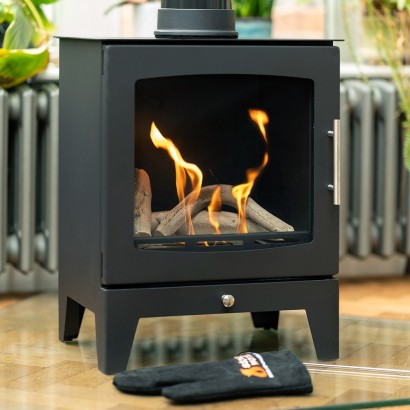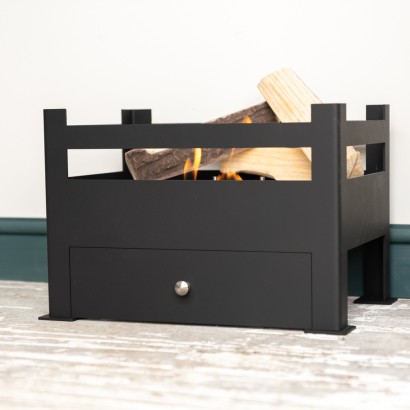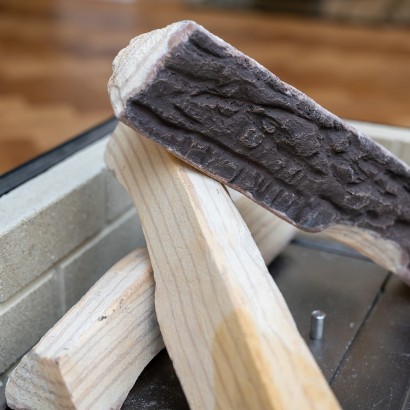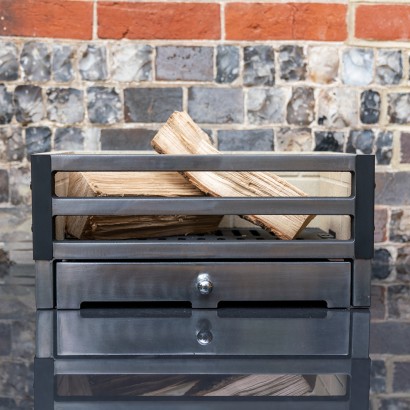Bio Stoves Frequently Asked Questions

This guide answers some of the most common questions we are asked about bio stoves, from ceramic logs to troubleshooting common issues.
Will my bio stove give out heat?
Yes, a bio stove will produce a few kilowatts’ worth of heat, around the same as a double radiator or electric heater. The exact amount of heat can depend on the fuel; better quality fuels can give off more heat.
Why is my bio stove producing a smell?
Assuming the bio stove has reached a hot enough temperature to clear the curing phase, then there is nothing on the stove that can continue to produce a smell. Below are some common causes of a smell being produced.
-
The bio fuel itself is not as advertised. It may be worth trialling a few other brands.
-
If you have ceramic or decorative logs in your fire, ensure they are not laid over the flames. This can produce a smell and also cause the flames to rise higher than they should. If you have ceramic or decorative logs around the fire and there is a draught getting into the bio stove, it may be that the flames are being blown onto the logs, causing them to smell. In that case, you want to try and eradicate the draught or move the logs further away.
-
The stove is struggling for oxygen. At the end of a burn cycle, the stove can begin to produce a smell as it struggles to burn what is left. This struggle can produce a smell of un-burnt biofuel. The best way to avoid this is to close the flap off as the fire begins to slow down. The fire can also produce this smell at the beginning and to help prevent this, make sure the fuel is at room temperature and not cold. Cold fuel is much harder to light. If the problem persists it may be worth looking at different bio fuel brands.
-
If you have not used the bio stove for a while, it may be dust on the fire producing a smell, or something around it getting warm.
How do I stack ceramic logs?
Ceramic logs must not be positioned over the flames. On smaller models it may be that the bio logs are placed on the burner box flap. That is fine, as long as the hook can still connect with the points on the box to close the fire off. It may be that closing the fire off dislodges the logs and these will simply need re-setting when they are cold. In most cases the flap will only need moving once, before the burn cycle, as bioethanol stoves do not need constant air adjustments like wood burning stoves.

Stacking ceramic logs

Ceramic logs must not be positioned over the flames
Why is my bio stove not closing down when I close the flap?
The bioethanol stove is controlled by the flap on the bio box. This is opened and closed with the stainless steel hook provided. When the flap is closed, the flames should stop. In some cases, this cannot fully extinguish the flames.
It is important not to panic and to remember that the fire is contained in a box and will eventually die out anyway. In some cases the flap may just need pulling back and forth a few times. The most likely causes of this happening are:
-
There is some fuel on the underside of the flap. In this case, you need to wipe down the flap and try again.
-
The flap has become distorted and needs replacing. If distorted, it will continue to let air in underneath, continuing the burn. To check if it is flat, simply place it on an object that is known to be flat and see if it is raised at any point.
-
Incorrect fuel. If the fuel is wrong, or has a higher than advertised alcohol content, it can be harder to close down. This will often be in conjunction with the flames burning higher and hotter.
Can I store my bio fuel indoors?
Yes, bio fuel can be stored indoors. We suggest a dry cupboard at least 3 metres away from the fire. Make sure your fuel is at room temperature before burning, as cold fuel can be much harder to light. Always ensure that bio fuel is kept out of direct sunlight.
Do bio stoves produce smoke and carbon monoxide?
No, they do not. The only by-product of a correct burn cycle is heat and carbon dioxide. The amount of carbon dioxide produced is similar to that of burning a few candles. The curing process of the paint can produce a haze on the top of the fire which can set off sensitive carbon monoxide and smoke alarms. After a few burns this should clear. If alarms continue to be triggered after the curing process, it may be worth removing any ceramic logs, as the flames may be hitting these and causing a burning smell, as well as trialling some different fuel.
Can I hang a TV directly over the bio stove?
Yes, as a bio stove does not produce any smoke. However, we suggest using the blanking plate provided, to cap off the series of holes on the top. This will ensure the heat is pushed back into the room rather than directly onto the TV’s underside. We suggest having the TV a minimum of 15 inches above the fire, even with the blanking plate in place.
Some examples from our customers of hanging a TV over the Hampton 5 Pure Bio:
What bio fuel can I use?
There are no unusual fuel requirements for our bio stoves. Any commercially available bioethanol fuel will do. There are numerous retailers selling bio fuel online, including EkoFuel and Planika.
Are bio fuel stoves safe?
Yes, bioethanol stoves/bio stoves are completely safe provided you follow the instructions carefully.
The most important safety tip is to never re-fuel a bio ethanol stove when lit.
Safety instructions and more information on how bioethanol stoves work can be found in our bio stove manual, which you can download here. You also recommend watching our bio stove user safety video.
Can't find the answer to your question? We are happy to help, please get in touch with us via email [email protected], or give us a call at 01256 889 397.
Bestsellers
Leo V Pure Bio Stove
£395.00 Ex Tax: £329.17
New - Leo X Pure Bio Stove
£395.00 Ex Tax: £329.17
Ecosy+ Bioethanol Fire Basket / Bio Fireplace
£132.00 £239.00 Ex Tax: £110.00
Ceramic Log Set For Bioethanol Stoves And Fireplaces
£44.00 Ex Tax: £36.67
Ecosy+ Hampton 5 Pure Bio Stove
£499.00 £545.00 Ex Tax: £415.83
New: Ecosy+ Hampton Vista 500 Pure Bio Stove
£639.00 Ex Tax: £532.50
Venus 18" Cast Iron Dog Grate - Fire Grate - Fire Basket (Wood - Coal and Bio Option)
£195.00 Ex Tax: £162.50

 0 item(s) - £0.00
0 item(s) - £0.00 






















